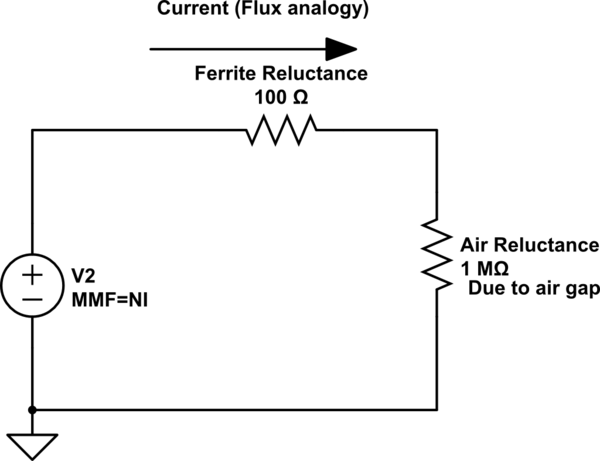I want to generate an AC magnetic field. However, when trying to do this with a ferrite rod electromagnet, the measured field strength (via magnetometer) was much lower than I expected. I found out that the inductance of this electromagnet was also much lower than expected due to the large "air gap/path" of a rod's magnetic circuit:
Inductor core permeability much lower than expected
My primary goal however is not to achieve a certain inductance, but to generate a certain (AC) magnetic field strength with a coil loop and ferromagnetic core. I figured the steps would be:
- Given a desired field strength \$B_{min}\$ at a specified distance \$d_{max}\$, determine the necessary dipole moment \$m\$.
- Given the permeability of a ferromagnetic material \$\mu_r\$ and its saturation flux density \$B_{sat}\$, determine the minimum volume \$V_{min}\$ of the material to achieve the desired \$m\$.
- Determine the necessary combination of turns \$N\$ and current \$I\$ to achieve the desired local \$B\$-field (and thus \$m\$) given the chosen volume \$V\$.
Solving these in order:
- Let's say I need a source dipole moment of \$m = .075Am^2\$ to generate the desired field. This is half the strength of a small neodymium magnet: https://www.kjmagnetics.com/proddetail.asp?prod=ZD2.
To determine the minimum volume, let's say I want to bring the material to saturation (\$B_{loop,center} = B_{sat}\$)in order to achieve minimum volume. In other words, I want \$V = V_{min}\$, and I will assume that the magnetic field generated by the coil is uniform everywhere in this small volume.
Assuming \$\mu_r\$ is large (e.g. >1000) and linear (even though this is usually not the case for ferromagnetic materials), we can say:
\$B = \mu_0(H + M) = \mu_0(H + (\mu_r-1)H)\$
\$\therefore B \approx \mu_0M\$
And because \$M = \frac{m}{V}\$, we have \$V = \frac{\mu_0}{B_{sat}}m\$.
For the 6.32mm diameter material with \$B_{sat} \approx .5T\$ referenced in my previous question, this results in a necessary volume of 377mm\$^3\$, or the rod with height 6mm.
Using the assumption of uniform \$B\$-field from the current loops to obtain a rough order of magnitude:
\$B_{loop,center} = \mu_0\mu_r\frac{NI}{2R}\$
Assume \$B_{loop,center} = B_{sat} = .5T\$, \$2R = 6.32\$mm, \$\mu_r = 2000\$ (type 77 ferrite)
This results in \$NI = 1.257A\$. So for example, if \$N=100\$, then the necessary \$I\$ is 12.57mA.
However, despite having the electromagnet configuration described above, and at least a few mA of current, I measure an extremely weak field that essentially requires the coil to be right on top of the magnetometer to see anything. Is there something wrong with my reasoning here? Does it again have something to do with the air gap?

